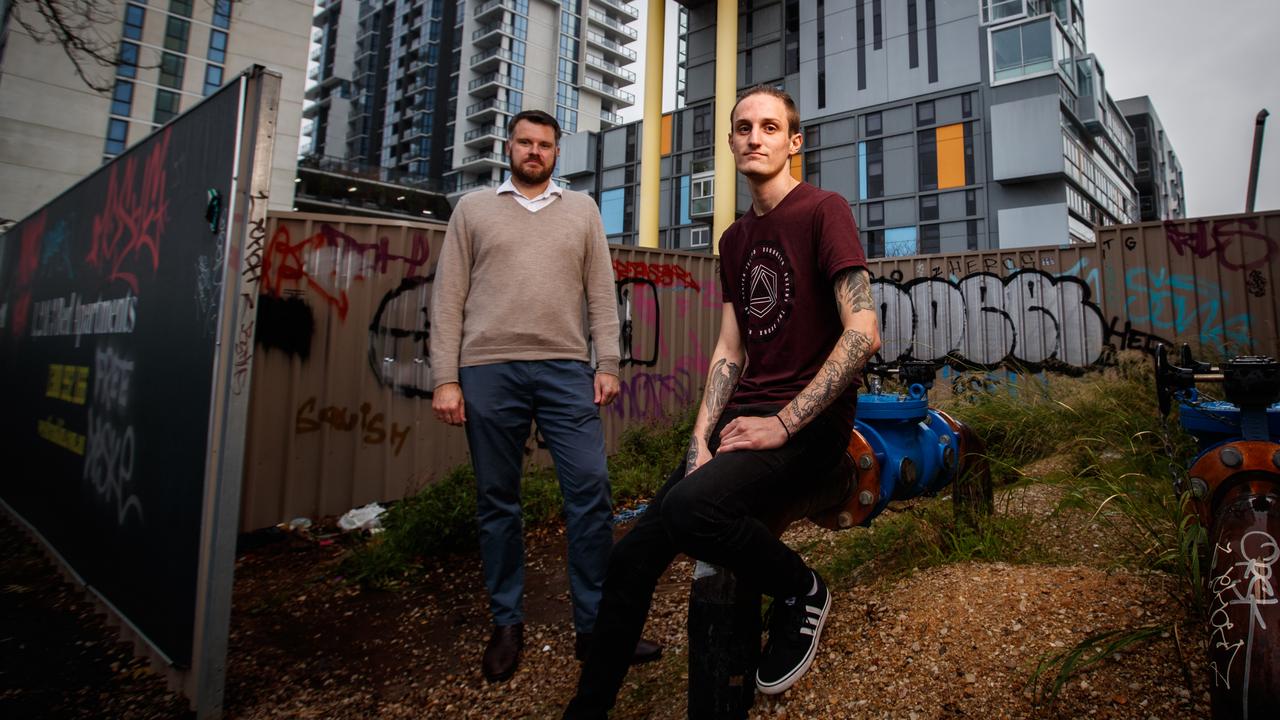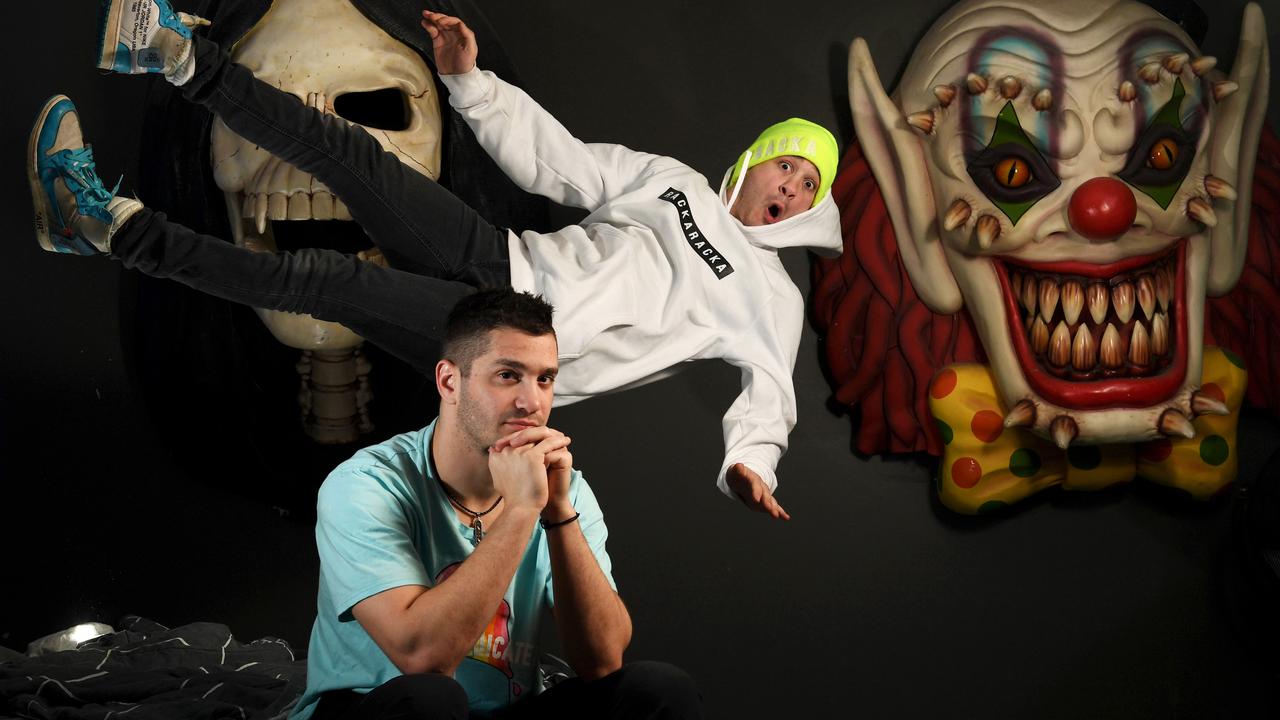SA Weekend: Two men and one twist of fate saved SA scientist
Richard Hillis — South Australia’s current Scientist of the Year — always regarded himself as fit bloke. However, one morning he had a heart attack on his regular run — yet for all his horrid luck, what happened next saved his life.
SA Weekend
Don't miss out on the headlines from SA Weekend. Followed categories will be added to My News.
- Heart age test: Check how old your heart is
- National screening: Kyle Chalmers urges regular heart checks
Three men gather in a pub on a warm Thursday evening in Adelaide.
It’s not the first time they have been in each other’s company. Still, one of their number has no recollection of that first meeting.
It was a Saturday, Australia Day this year in fact, about a quarter past nine in the morning.
At the time, Richard Hillis was face down on the footpath just outside Marryatville High School in Adelaide’s eastern suburbs.
He had been on one of his regular morning runs when he suffered a massive heart attack and collapsed.
A man who regarded himself as being among the fitter 54-year-olds going around was the victim of four massively clogged arteries.
But outside of a marginally high cholesterol reading, he says there was no warning signs of just how much danger he was in when he set out for his run that morning.
“I wouldn’t have gone for a run if I didn’t feel fine,” says Hillis, who was last year’s South Australian Scientist of the Year.
It turns out Hillis, as he readily admits, was simultaneously a victim of outrageously bad luck – and outrageously good luck.
Seconds after he fell to the ground, Daniel Rowe was driving past on his way to work.
Rowe works for the Royal District Nursing Service and has extensive experience in cardiopulmonary resuscitation.
Rowe saw the commotion on the footpath, figured a runner had probably tripped over, maybe grazed a knee, needed a little first aid and stopped to see if he could help.

About the same time, Jade Lewis was also nearby, on his way to the gym.
Lewis is in the Army and trained in CPR. When Lewis and Rowe arrived, Hillis was still face down.
They still weren’t sure about the extent of the problem. Then they turned him over.
“It wasn’t until Jade said ‘we should roll him over’, I saw he was blue and I said ‘we have to start CPR, because this is not looking good’.”
For seven minutes until the ambulance arrived Rowe and Lewis worked on Hillis.
They broke his sternum and a few ribs but saved his life.
But it was a close-run thing. The ambulance crew tried to restart his heart with an electric shock from defibrillators. The first attempt failed. More esperate CPR followed. Then a second shock brought Hillis back.
A month after his heart attack, Hillis still carries a look of fragility, not surprising after his experience, but when we meet he looks better than he probably has any right too.
He knows he could be, should be, dead. According to the Victor Chang Institute, the survival rate for someone who has a heart attack outside a hospital is around 10 per cent. The Institute also says that the first three-to-five minutes after the heart attack are the key to survival.
Yet here is Hillis, in the Toorak Gardens home from which he set off on Australia Day, well on the way to recovery.
Before the heart attack he believed he was fit and healthy.
Two years ago he walked the 1200km of the Heysen Trail from Cape Jervis to Parachilna. It took six weeks. Hillis, a geologist and a Scot, saw the trek as a pilgrimage to his adopted home and a really good way of looking at lots of rocks.
“I am passed the stage of feeling invincible but I was feeling pretty good,” he says.
“I love being fit and healthy. I love being outdoors. I love walking. I love looking at rocks.”
He hadn’t regarded himself as being a heart attack risk.
There was that marginally high cholesterol reading. He had felt a little more tired than usual. But there was no family history of heart disease. His mother is still alive at 91.
His father died from cancer aged 77.
Hillis is still processing that how and why of what happened.
“I have been struggling with it mentally, but more about ‘I thought I was OK, where did that come from’,” he says.
“What does it mean for my life? Am I going to run again? Am I going to enjoy having a few beers and a cheese plate?”
Hillis doesn’t take identification when running and after being taken to the Royal Adelaide Hospital he was registered as a “John Doe”. An unknown patient.
While all this was happening, his wife Belinda Hillis was becoming concerned. She was at home with son James and wondering what had become of her husband.
After James left for a cricket game, Belinda talked to a neighbour who worked for SA Police. The advice was to ring the police non-emergency number 131 444 to see if there had been any accidents reported in the area.
She made the call at 11.30am, two hours after she had expected her husband home from his run. “I thought if he was conscious he would have rung,” she says.
“It was a really sick feeling in the stomach having to ring the police and say ‘you might think this is silly, but my husband has gone out for a run and he hasn’t come back’.”
Belinda Hillis was told there had been no accidents and that she should ring the hospital.
She did, and of course was told there was no record of any Richard Hillis being admitted to the RAH.
The police rang back asking for a description of her husband.
They could take that to the hospital and hopefully be able to extract information that would not be given to a general member of the public.
So Belinda waited, not knowing, but fearing the worst.
Part of Hillis’s normal running route took him over Portrush Rd.
His wife knew the trucks and B-doubles that thunder down that road unnerved her husband.
“I thought he had been cleaned up,” she says. “I was just sitting there waiting for something to happen, having no control, all the thoughts about whether I would see him again.”
At 12.30pm, Belinda’s phone rang. It was a doctor from the RAH’s emergency department. He thought he was ringing the police.
He told her someone matching Hillis’s description had been brought into the hospital. He used words like “cardiac arrest”, “resuscitate”, “ventilator”.
She rushed to the RAH’s intensive care unit. A doctor took her into a room.
“Is Richard still alive?”, she asked.
Yes, she was told, but he’d had a heart attack and was unconscious. At that stage it was unknown if oxygen deprivation from the heart attack would cause lasting brain damage.
“[I had] all these thoughts about whether I would ever speak to him again, even though he was still alive,” she says.
“Saturday was the most surreal day I have ever had.”
The Sunday was better. Hillis woke up on the Sunday. He doesn’t remember much of that first 48 hours.
He was “shocked” to wake up in hospital and very “groggy”. The fentanyl prescribed to quell the pain was giving him horrible dreams and causing him to hallucinate.
“I remember looking at the clock and it was 7.24,” he says.
“Then I had a dream there was some mass murder I was involved in and it was just awful. Then I had a look at the clock and it was 7.25.”

Belinda, however, was feeling more optimistic. Hillis had opened his eyes and was speaking. By the “microsecond he got better”.
Surgery, a quadruple bypass, was scheduled for the public holiday Monday.
Belinda took this as a good sign. They wouldn’t be operating so quickly unless he was strong enough to cope with it.
Both Hillis and Belinda are very grateful to the paramedics who brought him in as well as the staff at the Royal Adelaide, the surgeon, the doctors, the nurses, the perfusionist, who assembled on a public holiday to look after him.
“It makes you reflect a bit on our medical service,” Hillis says.
“Obviously I arrive and they don’t know (who I am), no questions on whether I had private health insurance or could pay a bill. You hear so much bad about the RAH. But in terms of what happened to me it was fantastic.”
The time since the heart attack has been a time of recovery and reassessment for husband and wife, who celebrate 25 years of marriage in April. Hillis aims to run again.
Recently he managed a walk between Port Elliot and Goolwa.
The pair are planning a trip to Scotland to see their other son mid-year. Belinda says the whole “horrible” experience has given her a new perspective.
She says she is less reticent about expressing emotion to her husband and sons, “absolutely letting them know how I feel”.
There is also a desire to enjoy life more. The holiday mid-year will take in a visit to San Sebastian in Spain.
“I have pushed the boat out on the hotel,” Belinda says.
“We are going to get the room with the view. It’s going to cost us more but you can’t save for a later date, you have to enjoy it now.”
Both have new jobs as well.
Before the heart attack they had taken time off work.
Now, Belinda has, coincidentally, started working for the management company that runs the RAH.
Richard is returning to Adelaide University as pro vice chancellor research and performance.
He won his geologist of the year gong in 2018 for his work in developing a safer, cheaper and more environmentally friendly drill for the mining industry.
He says the close call with death has made him keen to go back to work.
“The only way I can describe it is that I want to write a new chapter,” he says.
“I didn’t want to just go into retirement after having this major medical incident. It would always make me feel like it had made me retire.”
Back at the pub, Hillis raises his glass of beer, his first since the heart attack, to his two saviours, Daniel Rowe and Jade Lewis.
“I owe these boys for life – I wouldn’t be here without them,” he says.
Both are delighted to see him doing so well.
Both, like all medical professionals, have more experience with situations like Richard’s turning out badly rather than well. “I feel pretty proud,” says Rowe. “It’s a pretty amazing experience.”
For first aid tips including CPR, go to stjohn.org.au/first-aid-facts


